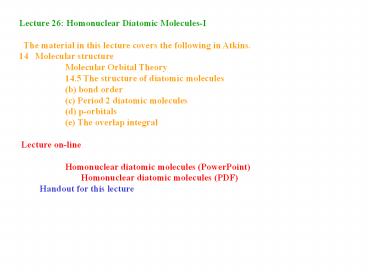Lecture 26: Homonuclear Diatomic Molecules-I - PowerPoint PPT Presentation
1 / 29
Title:
Lecture 26: Homonuclear Diatomic Molecules-I
Description:
Shape of molecular orbitals in homonuclear diatomic molecules ... The Occupation of homonuclear diatomic orbitals(PDF) (From the Wilson Group, ... – PowerPoint PPT presentation
Number of Views:337
Avg rating:3.0/5.0
Title: Lecture 26: Homonuclear Diatomic Molecules-I
1
Lecture 26 Homonuclear Diatomic Molecules-I
The material in this lecture covers the following
in Atkins. 14 Molecular structure
Molecular Orbital Theory
14.5 The structure of diatomic molecules
(b) bond order
(c) Period 2 diatomic molecules
(d) p-orbitals (e) The
overlap integral Lecture on-line
Homonuclear diatomic molecules
(PowerPoint)
Homonuclear diatomic molecules (PDF)
Handout for this lecture
2
Audio-visuals on-line Shape of
molecular orbitals in homonuclear diatomic
molecules (PowerPoint)(From the Wilson
Group,) Shape of molecular orbitals in
homonuclear diatomic molecules (PDF)(From the
Wilson Group,) Composition of orbitals in
homonuclear molecules (6 MB MBQuick-Time with
music) (A must from the Wilson Group,) The
Occupation of homonuclear diatomic orbitals
(PowerPoint)(From the Wilson Group,) The
Occupation of homonuclear diatomic
orbitals(PDF) (From the Wilson Group,)
3
(No Transcript)
4
(No Transcript)
5
(No Transcript)
6
The ground electronic configuration of the
hypothetical four-electron molecule He2 has two
bonding electrons and two antibonding
electrons. It has a higher energy than the
separated atoms, and so is unstable.
7
(No Transcript)
8
(No Transcript)
9
(No Transcript)
10
(a) When two orbitals are on atoms that are far
apart, the wavefunctions are small where they
overlap, so S is small. (b) When the atoms are
closer, both orbitals have significant
amplitudes where they overlap, and S may
approach 1. Note that S will decrease again as
the two atoms approach more closely than shown
here, because the region of negative amplitude
of the p orbital starts to overlap the positive
overlap of the s orbital. When the centres of
the atoms coincide, S 0.
11
The overlap integral, S, between two H1s
orbitals as a function of their separation R.
12
(No Transcript)
13
According to molecular orbital theory, ?
orbitals are built from all orbitals that have
the appropriate symmetry. In homonuclear
diatomic molecules of Period 2, that means that
two 2s and two 2pz orbitals should be used. From
these four orbitals, four molecular orbitals can
be built.
14
(No Transcript)
15
(No Transcript)
16
A representation of the composition of bonding
and antibonding ? orbitals built from the
overlap of p orbitals. These illustrations are
schematic.
17
(No Transcript)
18
A schematic representation of the structure of
? bonding and antibonding molecular orbitals.
19
(No Transcript)
20
(No Transcript)
21
(No Transcript)
22
(No Transcript)
23
(No Transcript)
24
(No Transcript)
25
(No Transcript)
26
(No Transcript)
27
(No Transcript)
28
(No Transcript)
29
(No Transcript)






























